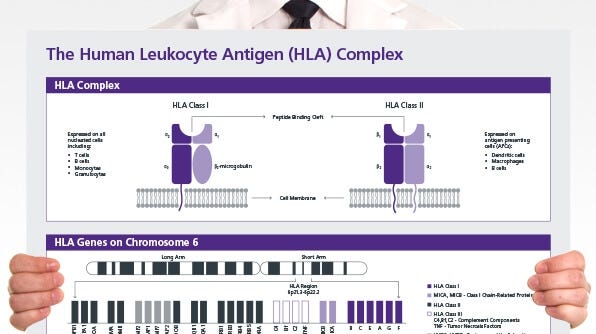Human Leukocyte Antigen Analysis
HLA molecules are heterogeneous membrane proteins that are critical for proper immune function. However, the diversity in HLA expression can lead to issues during organ transplantation as the transplanted tissue may be seen as foreign by the recipient immune system. Therefore, tissue transplantation labs typically perform HLA typing assays to determine which HLA subtypes are present on donor and recipient cells, as well as crossmatch assays to evaluate the degree of reactivity of donor cells to recipient anti-HLA antibodies.
Below is a collection of scientific resources for your HLA research.
The Human Leukocyte Antigen (HLA) Complex
This wallchart provides an overview of the human leukocyte antigen (HLA) complex, HLA genes and nomenclature of HLA alleles.
Get Your Free Copy >-
 The Nuts and Bolts of Lineage Chimerism TestingChimerism analysis is used to monitor the outcome of allogeneic hematopoietic stem cell transplantation. By looking at the presence of donor leukocytes within specific cell subsets of the hostā€™s peripheral blood, one can assess the success of donor cell engraftment or detect early graft failure, rejection, or relapse. Prior to performing chimerism analysis, different cell subsets must be isolated from the same sample to perform lineage-specific analysis. In this webinar, Dr. Cathi Murphey (Immunogenetics Lab Director; Southwest Immunodiagnostics, Texas) will discuss available technologies for isolating different cell subsets from the same sample and improving cell purity prior to chimerism analysis.
The Nuts and Bolts of Lineage Chimerism TestingChimerism analysis is used to monitor the outcome of allogeneic hematopoietic stem cell transplantation. By looking at the presence of donor leukocytes within specific cell subsets of the hostā€™s peripheral blood, one can assess the success of donor cell engraftment or detect early graft failure, rejection, or relapse. Prior to performing chimerism analysis, different cell subsets must be isolated from the same sample to perform lineage-specific analysis. In this webinar, Dr. Cathi Murphey (Immunogenetics Lab Director; Southwest Immunodiagnostics, Texas) will discuss available technologies for isolating different cell subsets from the same sample and improving cell purity prior to chimerism analysis. -
 How to Isolate Cells Directly from Whole Blood Using the EasySepā„¢ Purple/Silver MagnetsHow to isolate highly purified immune cells directly from whole blood and takes as little as 20 minutes from start to finish
How to Isolate Cells Directly from Whole Blood Using the EasySepā„¢ Purple/Silver MagnetsHow to isolate highly purified immune cells directly from whole blood and takes as little as 20 minutes from start to finish -
 Automate Cell Isolation for Up to 16 Samples with the RoboSepā„¢-16 Cell Separation InstrumentFeatures and benefits of using the fully automated cell isolation platform RoboSepā„¢-16 which allows you to efficiently isolate cells from up to 16 samples simultaneously
Automate Cell Isolation for Up to 16 Samples with the RoboSepā„¢-16 Cell Separation InstrumentFeatures and benefits of using the fully automated cell isolation platform RoboSepā„¢-16 which allows you to efficiently isolate cells from up to 16 samples simultaneously -
 How to Isolate Cells Directly from Whole Blood Using the Easy 50 EasySepā„¢ Magnet: 30-Minute ProtocolHow to isolate highly purified immune cells directly from whole blood samples of up to 30 mL with and the protocol takes as little as 30 minutes from start to finish
How to Isolate Cells Directly from Whole Blood Using the Easy 50 EasySepā„¢ Magnet: 30-Minute ProtocolHow to isolate highly purified immune cells directly from whole blood samples of up to 30 mL with and the protocol takes as little as 30 minutes from start to finish -
 How to Isolate Cells Directly from Whole Blood - EasySepā„¢ Direct Protocol, EasyEights MagnetHow to isolate highly purified immune cells from up to 16 whole blood samples at once with EasySepā„¢ Direct on the EasyEights EasySepā„¢ Magnet and the protocol takes as little as 25 minutes from start to finish
How to Isolate Cells Directly from Whole Blood - EasySepā„¢ Direct Protocol, EasyEights MagnetHow to isolate highly purified immune cells from up to 16 whole blood samples at once with EasySepā„¢ Direct on the EasyEights EasySepā„¢ Magnet and the protocol takes as little as 25 minutes from start to finish








